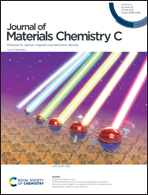Shear-aligned tunicate-cellulose-nanocrystal-reinforced hydrogels with mechano-thermo-chromic properties†
Abstract
The development of cellulose nanocrystal (CNC)-based responsive optical materials with highly durable structure colors has received growing attention. However, stimuli-responsive optical hydrogels with CNCs in chiral nematic arrangements are insufficient for practical applications, due to factors such as their long assembly time and the agglomeration caused by the high percentage of CNCs. Herein, mechano-thermo-chromic hydrogels with uniform interference colors are fabricated by the directional shearing of tunicate cellulose nanocrystals (TCNCs) and subsequent locking of the aligned TCNCs into poly(N-isopropylacrylamide) (PNIPAM) networks. Due to the higher aspect ratio and crystallinity of the TCNCs, iridescence birefringence appeared at a lower concentration. Shear-oriented TCNCs at a moderate concentration (∼5 wt%) not only endow nanocomposite hydrogels with uniform interference colors, but also improve the mechanical properties of the hydrogels. The oriented TCNC/PNIPAM hydrogels display reversible and distinct responsiveness to tensile force, compression, and temperature. This work offers a new strategy to design TCNC-based sustainable and stretchable responsive optical devices for sensors, environmental monitoring, and anti-counterfeiting labels.



 Please wait while we load your content...
Please wait while we load your content...